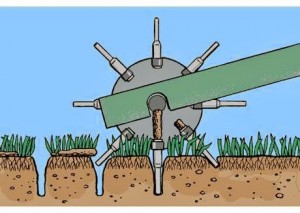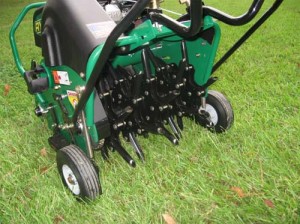
SOUTHERN UTAH / ADVERTORIAL —This time of year, the ground beneath your lawn is either beginning to thaw or has thawed with the record high temperatures experienced, marking the beginning of a new season and the time for your first fertilizing application. However, achieving a lush, green lawn takes more than just fertilizer. A healthy root system is imperative to achieve a long lasting, vigorous lawn.
The “thatch” layer
Grass develops a tightly meshed layer of slow decomposing roots and stems called thatch, that grows just above the roots. This layer of organic material can starve your lawn from essential elements it needs to grow.
“Grass develops a tightly meshed layer of slow decomposing roots and stems called thatch.”
“Where the grass roots are, they don’t break down real fast,” Tate Cleverly of St. George’s Morgan Lawn and Pest Control said. “So they can accumulate what is called a thatch layer that prevents water, air and nutrients from getting down into the soil to the roots.”
If the thatch layer grows to more than an eighth of an inch, it can really begin to affect your lawn’s health, Cleverly said. If untreated, the roots will begin to grow into the thatch layer, which will act as a sponge, sucking up water before it can reach the deeper roots.
Without aeration, lawns will begin to thin and dry out when it starts to get hot.
Aeration
The process of aerating your lawn helps to break down the thatch layer and allows for nutrients to flow into the soil so the grass can grow.
 The process of aeration involves punching small holes into the ground that allow for the grass to better absorb the nourishment it needs.
The process of aeration involves punching small holes into the ground that allow for the grass to better absorb the nourishment it needs.
In Southern Utah, the soil is clay based and more easily compacted.
“We have such a clayish soil that, just from watering or walking on the lawn, it compacts the soil so the roots have nowhere to grow,” Cleverly said. “Aerating helps relieve the compaction in the soil.”
When to aerate?
The best time to aerate is during peak growing season, which would be spring or fall.
“You don’t want to do it when it’s real hot,” Cleverly said, “because then what you’re doing is basically exposing the roots to the sun and the heat, which will dry out the roots quicker.”
 Cleverly also said that for fertilizer application to be effective, you should wait until after aerating the lawn.
Cleverly also said that for fertilizer application to be effective, you should wait until after aerating the lawn.
Generally, the first fertilizer application of the year has a preemergent herbicide in it, which creates a protective barrier on the grass. Once that barrier is penetrated it becomes useless.
“Once that preemergent is down, you don’t want to do anything to disturb the soil,” Cleverly said. “If you’re going to fertilize, you need to aerate first.”
The best time to aerate is now through March.
Resources
Morgan Termite and Pest Control | Telephone 435-673-9172 | call for an estimate or with any questions concerning your lawn.
A D V E R T O R I A L
Related posts
- Winterizing your lawn now will pay off next year
- Water Conservancy District schedules garden workshops for the public
- After the rain, termites swarm; they eat wood, food storage, more – 2014
Email: [email protected]
Twitter: @STGnews
Copyright St. George News, SaintGeorgeUtah.com LLC, 2015, all rights reserved.